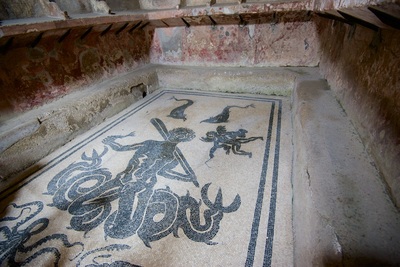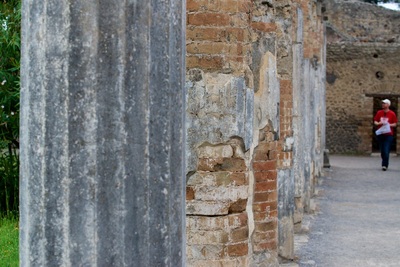Saturday, May 16, was a free day. Many students planned to travel the picturesque Amalfi Coast. I took the chance to spent more time in Pompeii and visit its sister city in volcanic tragedy, Herculaneum. Both are accessible by a commuter train that runs between Sorrento and Naples.
The first stop was Herculaneum. In 79 AD, was a smaller city than Pompeii. But the volcano treated the two towns differently, and sent a mighty pyroclastic flow that carbonized organic material. This means that a few pieces of wood can be seen in the city. The wood was flash-heated, so to speak. Also, a greater portion of in-home frescos can be seen on the walls. And in one house, I saw my first interior staircase for what were often two-story homes (though most roofs didn't survive the heavy rain of material from Mount Vesuvius).
Then I hopped back on the Circumvesuviana train toward Sorrento and stopped at Pompeii. This was my third trip to Pompeii but my first without a guide. I used the time to explore the less-touristy areas. I found several homes with marvelous frescos, another bath house, and the (closed to visitors) amphitheater.
I came away from the day amazed by Roman civilization. These people knew how to manage sanitation and water, regulated weights and measures, decorated their homes with amazing color schemes and intricate artwork, engaged in political sign-making and built the city square as a pedestrian-only zone.
Click on each picture to enlarge or click on the first an treat it as a gallery.
The first stop was Herculaneum. In 79 AD, was a smaller city than Pompeii. But the volcano treated the two towns differently, and sent a mighty pyroclastic flow that carbonized organic material. This means that a few pieces of wood can be seen in the city. The wood was flash-heated, so to speak. Also, a greater portion of in-home frescos can be seen on the walls. And in one house, I saw my first interior staircase for what were often two-story homes (though most roofs didn't survive the heavy rain of material from Mount Vesuvius).
Then I hopped back on the Circumvesuviana train toward Sorrento and stopped at Pompeii. This was my third trip to Pompeii but my first without a guide. I used the time to explore the less-touristy areas. I found several homes with marvelous frescos, another bath house, and the (closed to visitors) amphitheater.
I came away from the day amazed by Roman civilization. These people knew how to manage sanitation and water, regulated weights and measures, decorated their homes with amazing color schemes and intricate artwork, engaged in political sign-making and built the city square as a pedestrian-only zone.
Click on each picture to enlarge or click on the first an treat it as a gallery.
















 RSS Feed
RSS Feed